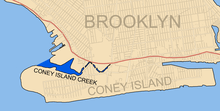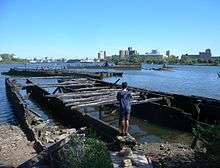Coney Island Creek
Coney Island Creek is a 1.8-mile-long (2.9 km)[1] tidal inlet in Brooklyn, New York City. It used to be a 3-mile-long (4.8 km) continual strait and a partial mudflat connecting Gravesend Bay and Sheepshead Bay, making Coney Island an actual island, but the eastern half of the creek was filled in by land owners and city construction projects during a period spanning the early to mid 20th century.[2]
| Coney Island Creek | |
|---|---|
A New York City Subway train crossing the Coney Island Creek | |
 | |
| Location | |
| Country | United States |
| State | New York |
| City | New York City |
| Borough | Brooklyn |
| Physical characteristics | |
| Source | Shell Road (emerging from storm drain under the road) |
| Mouth | Gravesend Bay |
| Length | 1.8 mi (2.9 km) |
Geography

Coney Island Creek extends eastward 1.8 miles (2.9 km) from Gravesend Bay to Shell Road and separates the west end of Coney Island from the neighborhoods of Gravesend and Bath Beach. The west end of the creek is bordered by Coney Island Creek Park and Kaiser Park on the south side, and Calvert Vaux Park on the north side.[3] The creek is crossed by the Cropsey Avenue and Stillwell Avenue bridges as well as two parallel rail trestles carrying the West End and Sea Beach subway lines (respectively served by the D train and N train). The eastern end is bordered by the Shore Parkway on the north side and Neptune Avenue on the south side. Marine traffic is restricted by a cable net between Cropsey and Stillwell Avenues. The eastern portion of Coney Island Creek runs along private industrial property and several acres owned by Keyspan, the local electricity provider. The creek terminates at Shell Road where a storm sewer emerges from under the road (designated stormwater outfall CI-641 in city plans).[4]
History
At the time of European settlement the land that makes up the present day Coney Island was several barrier islands with interconnecting waterways that were all constantly changing shape. The waterway that became Coney Island Creek did not originally extend across the back side of the island since part of the land on the west end was a peninsula called Coney Hook. Hubbard's Creek, which ran down the eastern side of the peninsula, connected directly with the ocean. In 1750 a one quarter mile long canal (called the "Jamaica Ditch") was dug through the Coney Hook salt-marsh from a creek connecting to Gravesend Bay east to Hubbard's creek.[5][6] This new waterway, allowing shipping traffic to travel from Jamaica Bay to New York Harbor without having to venture out into the ocean, connected Gravesend Bay and Sheepshead Bay together.[7][8] The waterway behind the islands was called Gravesend Creek in the early 19th century since it cut below the town of Gravesend (later the name was used interchangeably with "Coney Island Creek").[9][10] Eventually Hubbard's and the other creeks and inlets that separated the islands were filled by a combination of natural process and land development, leaving just a single island that came to be called Coney Island and a single creek behind it that came to be called Coney Island Creek.

Coney Island Creek was still a minimally navigable waterway over its 3-mile length through the turn of the 20th century. In a period from the late 19th century through the early 20th century there were plans to turn the creek into the Gravesend Ship Canal.[12] The plan including re-dredging the creek into a canal running in a straight east-west line and filling all the marsh land either side of the creek to expand the urban grid to the edge of the canal. The plan was eventually abandoned and by 1924 local land owners had filled a portion of the creek.[13] A major section of the creek was further filled in to allow construction of the Belt Parkway in the 1930s. More fill was added in 1962 with the construction of the Verrazzano-Narrows Bridge.[14] This turned Coney Island Creek into an inlet with the western and eastern ends of the island becoming peninsulas. None of the creek remains at the eastern end and that terminus, Sheepshead Bay, has been dredged and, for the most part, enclosed in bulkheads. The path of the landfill of what used to be the creek follows Shore Parkway, Guider Avenue, and the triangular block between Neptune Avenue and Cass Place to a bulkhead at Sheepshead Bay.

A northwestern part of the creek is known as a "ship graveyard" for the dead and abandoned ships found there.[14] At southern shore of the creek, the remains of a 45 feet (14 m) yellow submarine, the Quester I, protrudes from the water. Built from salvaged metal in the late 1960s, it was never able to maintain an even keel and was abandoned.[15]
Though heavily polluted, Coney Island Creek was expected to undergo some minor cleanup between 2018 and 2020.[16] By 2021, a NYC Ferry stop is expected to be added along the creek.[17]
References
- Coney Island Creek Resiliency Study, New York City Economic Development Corporation (NYCEDC) - 2016.07.08, pages 14-15
- Kadinsky, Sergey (2016). Hidden Waters of New York City: A History and Guide to 101 Forgotten Lakes, Ponds, Creeks, and Streams in the Five Boroughs. Countryman Press. pp. 200–203. ISBN 978-1-58157-566-8.
- Kensinger, Nathan (November 20, 2014). "Coney Island's Untamed Creek, Caught Between Past & Future". Curbed NY. Retrieved September 23, 2019.
- "Coney Island Creek Combined Sewer Overflow, Long Term Control Plan - NYC Environmental Protection, November 4, 2015, page 15" (PDF). Archived from the original (PDF) on March 1, 2017. Retrieved October 24, 2017.
- 1884 history calls this other creek "Brown’s Creek" and period maps show a mill pond in this area and call it "Mill Creek"
- City in Environment - Evolution Coney Island
- William H. Stillwell, A History of the Town of Gravesend, N.Y., 1884, page 34
- Coney Island History Project, Collection - Jamaica Ditch
- New York City Department of Parks & Recreation, Coney Island Creek Park
- Cover G. Tremlett, In the Matter of the Application of the City of Brooklyn to Acquire the Property and Franchises of the Long Island Water Supply Company: Before ... Commissioners of Appraisal. Proceedings and Report of the Commissioners, 1893, page 273
- NYC Parks Dept Coney Island Creek Park
- Hidden Waters blog, Companion blog for the book "Hidden Waters of NYC" - Photo of the Week March 4, 2016
- Lamb, Jonah Owen (August 6, 2006). "The Ghost Ships of Coney Island Creek". The New York Times. Retrieved June 11, 2014.
- Moynihan, Colin (November 9, 2007). "In Coney Island Creek, Hulk of a Yellow Submarine Sticks Out". The New York Times. Retrieved September 12, 2014.
- "Liquid gold: State hands out thousands to four groups for projects to clean up Coney Island Creek". Brooklyn Paper. December 7, 2018. Retrieved May 6, 2019.
- "Ferry uneasy: City named Coney Creek as site for nabe's new ferry before solving critical logistical, environmental issues, locals say". Brooklyn Paper. February 8, 2019. Retrieved May 6, 2019.